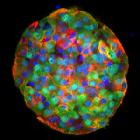 |
||
post-transcriptional control of gene expression
Once transcribed there are further opportunities for gene regulation, including regulation of mRNA stability and regulation of the translation of mRNA into protein. These forms of regulation are known as post-transcriptional regulation and play important roles in both normal physiology and organismal development. Recently a novel class of genes, known as microRNAs (miRNAs), has been described that are able to post-transcriptionally regulate gene expression in sequence–specific manners. MicroRNA biogenesis starts like many genes with transcription factor regulated RNA polymerization. Following transcription, the long primary RNA transcripts are sequentially processed by two RNAse-containing enzyme complexes (Drosha and Dicer) into small double-stranded RNA molecules. These molecules then act to regulate gene expression in a manner similar to small interfering RNAs.
Do miRNAs regulate pancreas formation and β-cell genesis?
Although a large body of evidence demonstrates that transcriptional control is important for β-cell development, there have been only few studies describing the role of post-transcriptional regulation or miRNAs in the process. We genetically ablated Dicer1 to prevent miRNA expression at three different pancreatic developmental time points. Using this approach we determined that miRNAs are necessary for generation of pancreatic β-cells, but only when genetically removed early in the developmental program upstream of neurogenin 3. Additionally, using both cloning strategies and other approaches we have determined which miRNAs might be important during this developmental period.



